Introduction To Training Your Dog

Dogs can be a wonderful addition to any home. Your furry friend will provide you with companionship and love that can hardly be matched by anything else. Of course, having a dog can also be stressful, especially if they aren’t trained yet.
Training your dog can cause a lot of frustration, but it’s definitely worthwhile in the end. Naturally though, if you haven’t owned a dog before then there’s a good chance that you may not know how to correctly train your dog.
We can’t all be Cesar Millan! So, what should you do in order to train your new pet? Here’s everything you need to know.
- Introduction To Training Your Dog
- Why You Should Train Your Dog
- 1. Using Positive Reinforcement to Train Your Dog
- 2. Practice Sit and Stay
- 3. Other Commands to Practice
- 4. Reliable Recall
- 5. Recall Games
- 6. Leash Training
- 7. Train During ‘Dog Time’
- 8. No Biting or Nipping
- 9. Reward Good Behavior
- 10. End Training on a Positive Note
- Summary
Why You Should Train Your Dog

You have probably heard the phrase “you can’t teach an old dog new tricks” before, but whether you are about to welcome a new puppy into your home or you are adopting an older dog from a rescue shelter, training your dog is absolutely essential.
While it might be tempting to skip this step due to the work involved, this is a bad idea. Here are some of the key reasons why you should train your dog.
Correct Training is Among Your Dog’s Basic Needs
Just like eating, drinking, and sleeping, providing your dog with the right training is another one of their basic needs. This will result in a much happier pup as well as a happier human!
With the right training, you will be able to leave your dog at home for short periods of time without worrying that they might hurt themselves (or certain things in your house) while you are not there. A well trained dog is one that is well adjusted to the domestic environment.
Similarly, a dog that has been given the proper training will be less likely to put themselves in a dangerous situation when you are out and about on a dog walk. Good recall, for example, can help keep your dog from harm as they will respond to their name when off-leash.
Here are another five key reasons why correct training is among your dog’s basic needs:
- Training together helps you and your dog bond.
- Your dog will feel like they’ve achieved something which is good for their wellbeing.
- It can help keep your dog safe in dangerous situations.
- Your dog will be more obedient at home and outside.
- They will have better social skills with other people and animals.
So, when should you start? Well…
It is Crucial to Start Training Your Dog as Soon as Possible
When you first get your new pet, it’s important that you get to work on training them as soon as possible.
Your dog learns a lot while they are still young and especially as a puppy, so it is best to take advantage of this in the first few weeks of their life and after they come home.
This is just one of the many reasons why you should do thorough research on the dog breeder you are considering if you are buying and not adopting a dog, as the best breeders will ensure that your dog is socialized in those first eight weeks before they join your family.
If you continue to teach them early on and after they come home, your dog will be much less likely to develop unwanted behaviors later on which can be harder to unlearn.
1. Using Positive Reinforcement to Train Your Dog
Positive reinforcement is one of the most important aspects of dog training.
Dogs, by nature, want to please their humans and to make them happy. Therefore, showing them positive reinforcement is one of the most powerful and effective ways to encourage good behavior.
Although positive reinforcement can include toys and praise, which we will discuss in more detail towards the end of this article, here we focus on treat-based positive reinforcement.
Here are the top 3 reasons why you should be incorporating positive reinforcement into your dog’s training:
1) How to Utilize Positive Reinforcement
Treats are one of the most effective ways to incorporate positive reinforcement into your dog’s training as the majority of dogs (and especially puppies) are highly food-motivated.
Choose your treats wisely, though! You can’t just give your dog any old scraps and expect them to work hard to earn more. Excellent dog training treats can include:
- Something enticing and irresistible. As every dog is different, you should experiment with different treats to find out what your dog gets most excited about.
- Something small. Treats should be about the same size as a pea (or smaller when they are still a small puppy) so you can be generous with the treats during training without accidentally overfeeding your dog as this can lead to them gaining weight.
- Something soft. You don’t want your dog to be chewing away for the next five minutes, so give them a soft treat they can quickly eat and then get back to training.
- Some variety. Dogs are highly intelligent and can become bored quite quickly, so keep a selection of treats handy to keep your dog interested in earning their reward.
The basic principles of utilizing positive reinforcement are to quickly reward your dog after they have correctly followed your instructions or completed a command.
Follow this up with some verbal praise and eventually, you should be able to cut out the treats altogether.
2) Many Dog Professionals Agree that Positive Reinforcement is the Best Way for Dog and Trainer
Your dog is simply going to be more likely to continue to perform good behaviors if they are rewarded for them.
So, if you ask your dog to stay and they obey, you should then give them a treat. Eventually, they will perform the action without actually being given a treat.
One technique that many experts recommend that can be very effective is clicker training.
With this, you put treats inside of a clicker. Then, when your dog does something that you want them to do, you click on the device and a treat is given to your dog.
Eventually, your dog will come to associate the sound of the clicker with positive things, so you can simply use the clicker without the treats as the reward.
It’s a very effective training method. It isn’t necessarily very good for removing behaviors you aren’t happy with, however.
When you are training your dog, it’s best to start off by giving them rewards every single time that they do something good. After a while, you can then give them rewards every now and then as the behavior is becoming like second nature to your dog.
Likewise, make sure that you aren’t rewarding bad behavior too. Only good behavior should be rewarded, remember!
3) Dogs Will Repeat Good Behavior When it is Followed by a Reward
In the past it was believed that punishing a dog was the best way to train them.
This couldn’t be farther from the truth. Have you ever heard of Pavlov’s Dog? To sum it up in a nutshell, the dog featured in the study was given treats in exchange for performing a certain action.
Later in the experiment, the dog continued to perform the action, despite there being no treats involved. If your dog feels that they are going to be rewarded for a behavior, they are more likely to repeat it. As such, positive reinforcement can be a very effective tool to use.
2. Practice Sit and Stay

When you think about training a dog, one of the first commands that you think of is probably ‘sit’ or ‘stay’. These are fundamental skills for your dog to learn – here are 4 reasons why.
1) Sit – One of the Most Basic Commands
When you are first starting to train your dog, it’s often best to start off with simple commands.
Not only will learning these commands help familiarize your dog with the concept of training which will make future training easier, but the simple commands often provide the foundations for harder commands, such as lie down, spin, and even recall training.
With the ‘sit’ command, you can usually teach this to your dog in a matter of days provided that you are consistent and continue to practice after they have mastered the command.
2) A Dog Who Knows Sit Will be Much Calmer
If you have a particularly energetic dog, teaching them to sit is essential.
The sit command can help your dog to calm down as it will force them to sit still in the middle of their excitement.
This can be an incredibly useful skill for your dog to have in certain situations, like when you are around other people and dogs or when people come to visit your home.
3) Stay – Helps Make Your Dog Easier to Control
Knowing your dog will listen to you is incredibly important, especially when the situation you are in becomes risky or even dangerous to you or your dog.
Teaching them to stay teaches them impulse control, meaning they are less likely to dive on your meals or give chase to a squirrel they may have spotted without stopping to check whether it is safe to do so.
The stay command is therefore essential for obedience training, and it goes hand in hand with ‘sit’ as one of the most basic yet important commands.
When you first introduce this command, ask your dog to sit, then ask them to stay with the associated hand action.
Once they have learnt to stay in one spot until they are told they can move, you will know that if the situation ever called for it, you can get your dog to stay until it is safe to move.
4) Helpful in Many Situations
There are a lot of situations where sitting and staying are helpful.
For instance, if you are doing some cooking in the kitchen and your dog is sitting in one place, they are less likely to trip you up. They are helpful commands for ensuring that your dog stays out of certain areas.
As we have mentioned, they are also important commands for the sake of your dog’s safety. If they know how to stay, they are less likely to run into dangerous situations.
For instance, if they are reactive to other dogs, then mastering the stay and sit commands will help to make sure you aren’t battling with a leash and your dog isn’t hurting themselves or another dog. You and your dog will both be safer if they are obedient and can follow these commands.
How To Teach Your Dog To Sit and Stay?
So, let’s get into the nitty gritty of how you can nail down these commands.
Teaching Your Dog To Sit
To teach your dog to sit, first grab a treat or your clicker.
When your dog is standing in front of you, hold the treat at the back of their head and then verbally say the word sit. The dog will generally sit on instinct in order to get a better look at the treat.
Sometimes your dog may not sit automatically – in this case, simply tap their behind while you are saying the command, and you can then give them a treat for obeying once they have parked their butt.
Teaching Your Dog To Stay
Then, you can move onto the stay command.
Tell your dog to sit to start with. Then stand in front of them with an open palm – like you are telling them to stop. While doing this, say the word stay and utter their name. Maintain eye contact with your dog, ensuring that they are remaining in the stay position for around 30 seconds.
When you have done this, you can then allow him to stop the stay using a word like ‘okay’ or ‘go’. Give them a treat for following the command. Eventually you can increase the amount of time that they spend in the position, ensuring that you reward them each time.
3. Other Commands to Practice
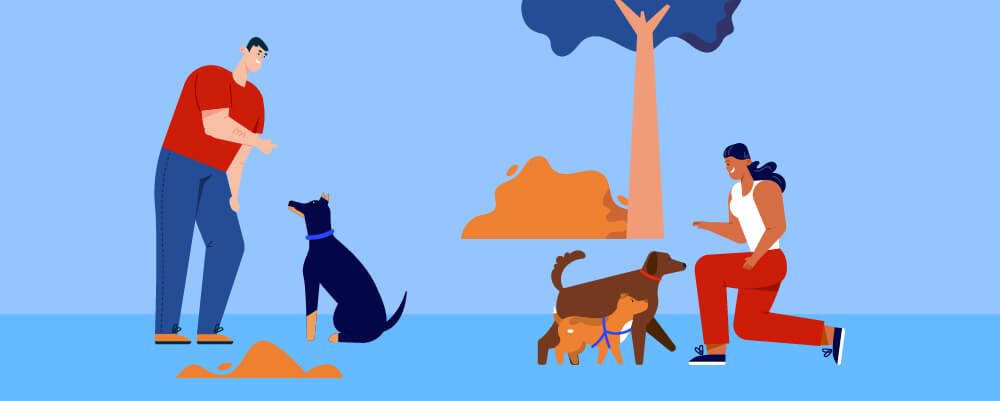
When you have the basic commands out of the way, the next thing that you need to do is teach your dog slightly more advanced commands.
These aren’t difficult commands by any means, but they certainly are essential and will make yours and your dog’s life much easier!
Come – Useful When Losing Grip on the Leash
Your dog should always know how to come when they are called. This can be useful in getting your dog’s attention, but it is also vital for unexpected circumstances.
For instance, if you were to accidentally let go of your dog’s leash, your dog might be able to run off.
Knowing the ‘come’ command means your dog will be more likely to return to you as instructed. In a similar vein, if your dog was to get out of your front door as someone is coming in, asking them to come will help you get them back inside where they are safe.
This essential safety command is actually pretty simple to teach, as well.
If you are taking your dog out for a walk, put their collar and leash on ready and, at a small distance from them, ask your dog to come to you. Give them a gentle nudge by tugging on their leash.
Eventually, your dog should figure out what you are asking of them and should come to you. Once they reach you, reward them with plenty of treats and praise. The end goal should be for your dog to listen to this command even when they are off-leash without you prompting it.
To practice this command without your dog’s leash from a further distance, choose a place that is safe and quiet where you are unlikely to be disturbed, as this could distract your dog.
Down – Teaches Your Dog Impulse Control
Another command that your dog should learn while they are still young is the down command, however, it is slightly trickier than other commands we have mentioned due to it requiring your dog to be in a submissive position. Like ‘stay’, this teaches impulse control.
If you are struggling to master this command, try to ensure that you are training in a relaxed, calm environment and try not to be too intense, especially if you have an anxious dog.
Any attempts to leave the ‘down’ position, such as sitting up, jumping, or moving towards you should be met with a firm ‘no’ to teach them that this is not what to do at this command.
To teach your dog the correct position, start by grabbing a great-smelling, great-tasting treat that your dog’s nose (and drooling mouth) will hopefully automatically want to follow.
Hold the treat up to your dog’s nose for them to get a good whiff of what is to come, then simply move your hand down towards the floor and your dog should move with you.
Then, slide the treat across the floor immediately in front of your dog. This will usually result in your dog’s body following his head (which is following the treat, of course) and will get them into the right position. Once there, say ‘down’ and reward your dog for getting it right!
Leave it – Helps Keep Your Dog Safe When They Find Something Dangerous
Dogs are curious creatures that often explore the world around them with their noses and mouths. As such, there will be situations where your dog decides to pick things up that they maybe shouldn’t be touching.
If you teach your dog the ‘leave it’ command, then it can help to protect them when they put bad things in their mouth.The key is to make it clear to your dog that if they obey this command, they are going to get something much better in return.
To do this, start off by putting a regular treat in one hand, and hold a top-tier treat in the other hand. Show your dog the closed hand with the regular treat and utter the ‘leave’ command.
Your dog may sniff or lick your hand, but do not reward this. Wait until your dog gives up and looks at you, then reward them with the tastier treat to teach them it was worth leaving.
As your dog becomes better at this command, they should start to look up at you as you are telling them to leave when they start to move away from the first treat more consistently.
4. Reliable Recall
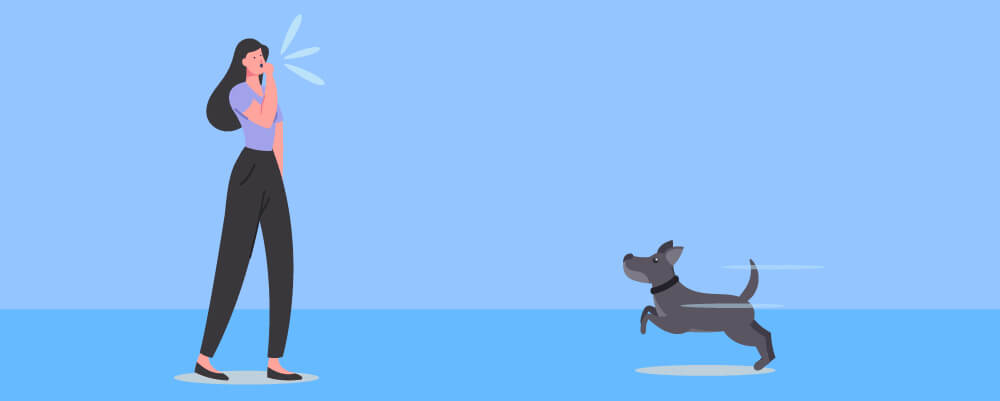
Reliable recall is one of the most important things to teach your dog, but it is also more difficult to master. Once your dog is familiar with and is consistently obeying some of the more basic commands, you can move on to practicing their recall which will help to keep them safe.
Reliable recall is exactly what it sounds like. When your dog has reliable recall, it means that they are going to return to you at least 99% of the time. This means that you can allow them off the leash too because you can trust them to listen to you when you are calling them.
So, how do you work towards mastering reliable recall with your dog?
Ensure Your Dog Enthusiastically Responds When You Call Them
When you are teaching your recall, they should respond to you enthusiastically. They should be excited to come back to you.
Once again, this is where your positive reinforcement techniques will come into play, as using treat-based incentives is a vital part of recall training.
Even if you are teaching your dog not to jump up at you, always reward your dog when they respond to your recall.
You should never punish your dog when they return to you, even if they are excitable, as you don’t want them to associate negativity with coming back to you.
The last thing you would want is to make your dog afraid of returning when you recall them.
Important When Letting Your Dog Off-Leash
Reliable recall will ensure that both your dog and other dogs will be safe when your dog is off-leash. This will allow them more fun and freedom when they are on walks as you can trust that they will come back when called.
There are some important things to keep in mind when you are doing recall training with your dog off-leash to ensure that they are safe.
The first tip is to rip the bandaid off as soon as possible. Training leads can be useful, but they can also hinder your dog’s process, so it is much better to pick a safe, preferably enclosed, quiet area where you can start practicing recall with your dog off-leash.
You can start training off-leash at home by calling your dog from the opposite end of the room as this will limit the amount of distractions you have to contend with while your dog is still learning. When your dog has mastered recall at home, start training in your backyard.
As Mardi Richmond puts it, “while 100 percent reliability may not be possible, the risks associated with a dog being off-leash will be greatly minimized through a combination of training and management”, so this is definitely a command you want your dog to master.
5. Recall Games
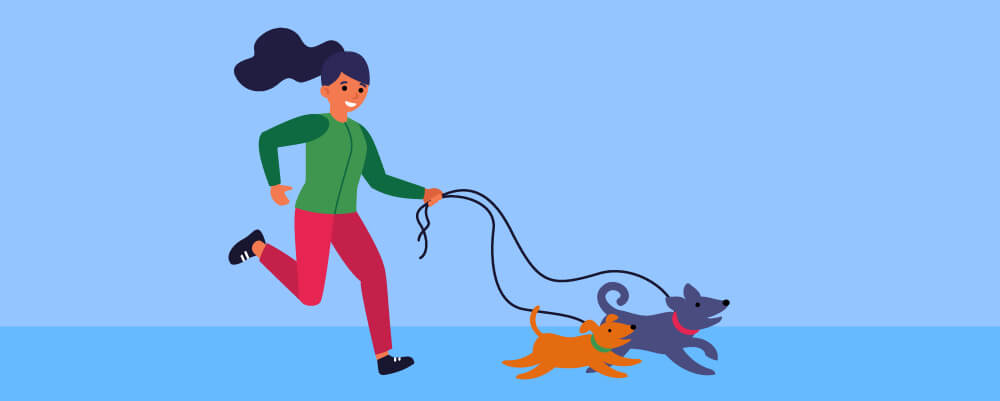
Mixing playtime with training? It’s a more effective combination than you might think!
Training Recalls – Make Training a Game for Your Dog
What better way is there to train your dog than to make it fun?
Turning recall into a fun game can make training much more enjoyable for your dog.
In fact, incorporating play into your dog’s training can be effective when teaching them all sorts of commands. This links back to positive reinforcement and how powerful a tool it can be.
Here are some of the most effective recall games that you and your dog can train with:
- Back and forth recall: You will need another person to play with you for this one as you take turns calling your dog between you. Make sure to reward your dog with fun and silly play, affection, and plenty of praise each time it reaches either of you.
- Hide and seek: Tell your dog to stay in one spot and hide in another room, then call them to come and find you. Greet your dog with enthusiasm and excitement and they will match it, meaning you can play this game when you’re out and about as recall.
- Dinner time: Allow your dog to watch you make dinner, then leave (taking the dinner with you) and call them to you from another room. Dinner will be their treat!
- “Who’s the Best Doggy” recall: When your dog comes to you after you call, roll around on the floor and play with them for a few minutes whilst praising them.
6. Leash Training
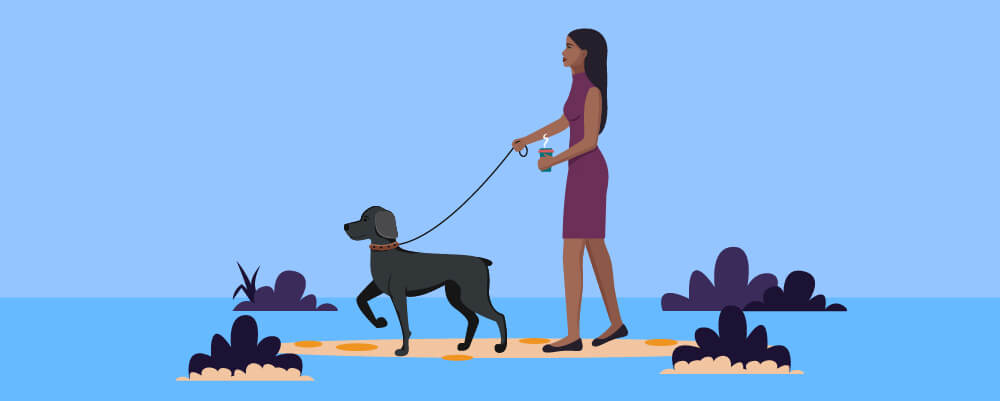
As important as off-leash training is for your dog, so is training them to walk on a leash.
If your dog is a pup, teaching them how to correctly walk on a leash should be no problem whatsoever.
For starters, begin by introducing the pup to the leash and the harness. Let them get used to the collar or harness when they are indoors, just while you interact with them. The dog should be able to associate the collar and leash with positive things.
Make them come to you using the techniques we have discussed in the previous sections. Practice walking with them by your side when they aren’t distracted by anything. Allow them to feel the leash on them as they walk, but don’t pull on the lead too hard or tug at them.
When your dog gets used to practicing with the leash inside, you can take them outside to really test their skills.
This could be more challenging as there are more distractions outside that your dog will want to investigate, so use your verbal cues to get them to respond to you when they are distracted and reward them accordingly. Eventually, they will be politely walking on the leash without incentives.
7. Train During ‘Dog Time’
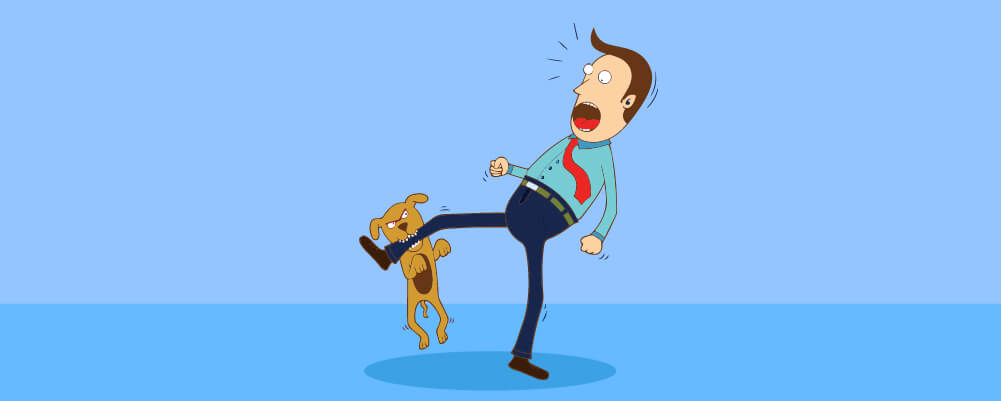
Training will be most effective when carried out at the right time.
For example, your pup probably isn’t going to be the most engaged when he is sleepy and ready for a nap. Similarly, if your dog is overly excitable and wants to play, they might not listen very well.
Try to follow their behavioral clues to work out when a good time for training is.
A lot of dogs will have lots of energy first thing in the morning because they know that’s when they are going to be fed, so you can use this to your advantage and train them at this time.
Ensure You Are Using the Right Training Technique When Your Dog is Doing Something Bad
Learning how to curb unwanted dog behaviors is a great way to help them settle in your home and become a part of your family.
It is harder to train your dog not to do something bad than it is to do something good, so try to prevent your pup from learning bad behaviors.
This could include puppy-proofing rooms your dog will be allowed in, keeping shoes and toys out of chewing distance, supervising your puppy to stop them doing things they shouldn’t be.
You can also use the following techniques to prevent unwanted dog behaviors:
- Jumping: Treat your dog calmly and don’t give them attention when they jump up at you as this will encourage them. Stand up or turn away from them. You can also ask your dog to sit when they begin jumping. For visitors, wait until your dog has calmed down before allowing them to greet your dog, perhaps using a baby gate or leash.
- Chewing: This is a common and normal habit for dogs as they go through a teething phase, just like human babies. The best tip is to keep your valuables out of reach and to provide plenty of toys that are meant for chewing. Alternatively, ‘leave’ is a good command to use if you do spot them chewing something. Exercise also helps.
- Leash pulling: No-one likes being pulled around by their dog, so stop whenever your dog pulls and refuse to move forward until they have stopped. This will teach them that they will not get anywhere by pulling. Make sure to be consistent with this!
- Barking: Barking is also a normal behavior for dogs, but it can become annoying, quickly. Teaching your dog to respond to “quiet” or “enough” as a command can help prevent them from being a nuisance to you and your neighbors.
8. No Biting or Nipping

Playing biting is not uncommon in dogs, especially when they’re puppies and they nibble at your fingers.
However, this is something that you will want to teach your dog not to do to avoid accidents. It might be cute when they’re tiny, but as your dog grows, so will their teeth!
Pretend You’re in Pain When Your Dog Bites You
The best way to teach your dog not not to bite is to teach them that they need to be gentle with their mouth during play. This is especially important if you have young children.
Allow your dog to put their mouth on your hands or skin, but if they start to bite or nibble, yell out or give a quick “yelp!” to signal that you are hurt.
This will often startle your dog and they should stop the behavior, in which case you can praise them and resume affectionate play.
If not, follow up with a stern “you blew it”. If your dog still doesn’t stop biting, put them in a time out where you ignore them and give them no attention, moving away if needed. Eventually your dog will learn that this is unwanted behavior and will become gentler.
9. Reward Good Behavior
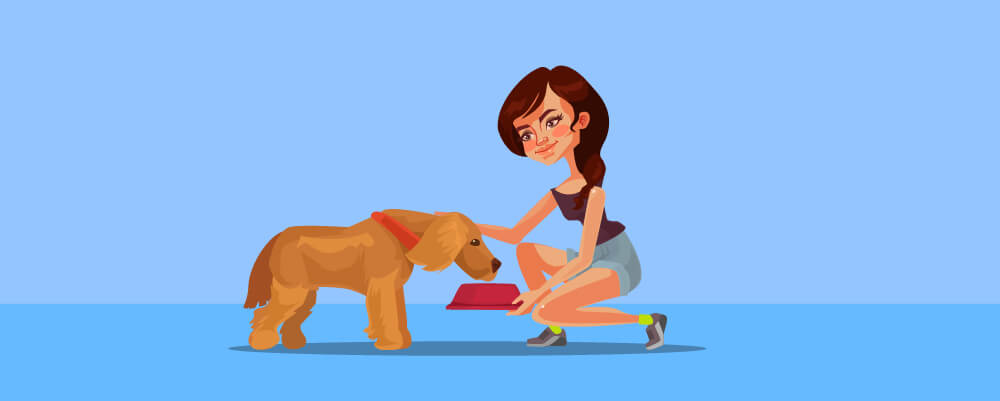
Reprimanding your dog is never the number one training choice.
Instead, you should be rewarding the kinds of behavior that you want to see! As promised, let’s take a look at the ways you can reward good behavior without treats.
Use Toys, Treats, and Lots of Praise
Like we mentioned earlier, the best way to reward good behavior is to use a combination of incentives. This will prevent your dog from becoming bored and learning what to expect.
It is also a good idea to reward your dog based on the level of what they have achieved. You should not give the same reward for completing ‘sit’ and for returning when called in the middle of chasing a pigeon, for example, as the latter is far more challenging for your dog.
As your dog learns, toys and praise will become just as if not more effective as a reward for good behavior, as some studies have suggested. So, remember to mix it up!
10. End Training on a Positive Note

Training can be frustrating, but it should never end on a bad note. Even if your puppy only makes a little bit of progress, they should be rewarded for that!
If you have been practicing complicated recall techniques and your pup is struggling, make sure you end the training session by giving them a few simpler commands that they already know. This will leave them in a much better mood and will make the next session easier.
Summary

Training a dog doesn’t have to be difficult. In fact, it can be pretty simple so long as you give it plenty of time and patience.
Training is important for teaching your dog good behaviors, but it’s also important bonding time too. When you train your dog, you are showing them that you care about them and love them.
Even just 15 minutes a day can go a long way for making a well behaved dog. And just remember – be patient. Dogs are very intelligent, but they don’t often learn things overnight. With time, your dog will be well behaved. Good luck!


